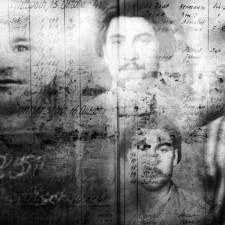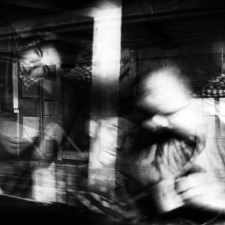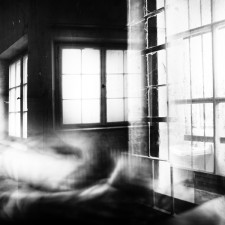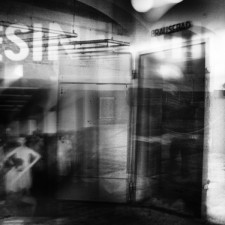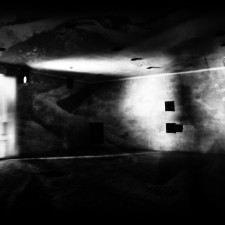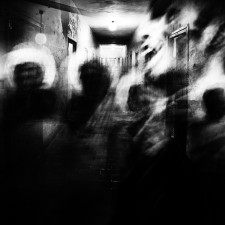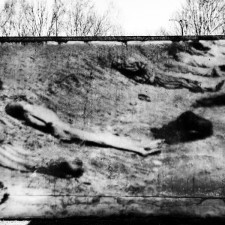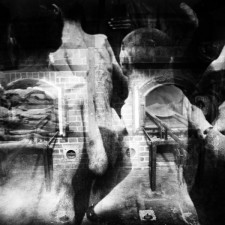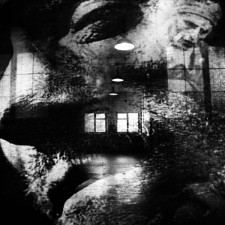The title of this series of photos is of course taken from the Gospel of John. This fact is hardly a coincidence and it has a logical succession on which we can and have to contemplate since such is our duty, as we shall see at the very end of this writing. So Jesus came forth, wearing the crown of thorns and the purple robe.
Pilate said to them: “Behold, the man!” (John 19:5) We may thus say without hesitation that Robert Hutinski took upon himself as a photographer the challenging task of speaking, through his series of photos, about the man, about the human, about the very human, and about the world, of what is at the very core of the world.
What is very human is necessarily committed to the universal. The photographer is aware of this and he is seeking to grasp his role in this world, his universal duty which is simultaneously the duty of each and every human being. The universal is a problem for any human being, not merely for philosophers and artists. And this comment should perhaps begin by stating what Descartes and Locke were already aware of: the sensible, the perceptible, is not a characteristic or a property of the objects in the world or even of the world itself; it is rather a relation, a set of relations because of which the world is layered and wrinkled, as Leibniz would have put it.
The twist in thinking is very important: Robert Hutinski’s series is correlated to this twist and this, too, is exceptionally important. Is simply means that a photographer does not take photos of the world or the objects within it as if they were a given; rather, he takes photos of relations, relationships, wrinkles, layers – something that is not and cannot be a given. In other words: Robert does precisely what is at the gist of human awareness of the world. We must not be misled into thinking that awareness reflects the world and the objects that have always been out there. Far from it: the world only exists insofar as consciousness transcends in the relation with it. Therefore, consciousness cannot be static, although our everyday may give the impression of it being precisely such.
The world is not static; it is not a given. Consciousness is not static and it is not a given either.
In fact, consciousness is quite different than commonly imagined in the everyday awareness and Robert is looking to discover what consciousness is like beyond the clichés and dogmas; he is trying to understand the anonymous consciousness, the emancipated consciousness of the common people and their anonymity – consciousness that may indeed by manifest most clearly in catastrophes like the Holocaust. Consciousness is, namely, always a problem – it is not a solution. Yet the beauty of this problem lies in the fact that the problem of the universal is connected directly to the problem of consciousness, which is of course very logical. Being does not pre-date what is presumably given; rather, it is given as something that pre-dates any given, to paraphrase the excellent French philosopher Quentin Meillassoux.
What does all this mean? It means that the relationship between thought and being, logically, pre-dates every empirical statement about the world. Hence, the world only has meaning if it is given to a thinking being. Robert is reaching with his photos into the heart of what is given to a thinking being. And what is at the heart of what is given? At the heart of what is given lies precisely something that is not given. Robert is exploring the consequences which are needless to say the most dramatically evident in a catastrophe like the Holocaust. The question is certainly valid: how could it have happened?
The answer to the question is anything but simple. What is at the heart of the world makes it always radically open. Therefore, any though or conception of a photographer looking at the world with her own eyes is false. A photographer cannot view the world with his own eyes because the world does not exist in any other way than a multitude of possibilities which of course are not given because they are virtual. And the subject (for example a photographer) is not an entity or a given; she is a multitude of possibilities.
How, then, does a photographer view the world? A photographer does not view the world; he creates it. Virtual possibilities are allowed by norms which make it possible for us to know or learn something; to see or understand. Without them, we cannot see nor understand anything. In this perspective, Robert is approaching philosophy as he is creating new egalitarian norms owing to which we are able to see and understand precisely because we never see the given. The condition of philosophy is recognition of the existence of something that is generically human and irreducible. In this perspective, every human being is equal to any other human being.
What is generically human is the condition of every possible world. Opening to the open, which is the fundamental emancipatory duty of an artist and a philosopher, can clash against obstacles that cannot be surpassed, which in turn can lead to apocalypse.
The objective of photography and philosophy is therefore radically the same: transformation of subjectivity, a new subjective position. Yet this transformation is not to take place in the world; rather it should occur in such manner as to make the (different, better) world possible. The backside of the insight about what is at the heart of reality is of course the story of the human ability to reduce what is irreducible. The Holocaust is nothing bit a gigantic attempt to constrict the human down to something inhuman. The Holocaust is therefore a machine entirely devoid of life. Robert is using the terrifying effects of its operation.
The Ecce Homo Series is thus at the same time about the human and about what Nietzsche called overhuman. A human is the only living creature that can destroy what is at the core of the world. Robert’s photos therefore do not involve simulated good-looking people or romantic scenes, because he unceasingly talks about the Holocaust as a machine, and about people within it.
We also discover in the photos what is characteristic of Wagner’s music. In his dramas, Wagner talks throughout about tanatos, the instinct of death which is eternity, infinity of suffering of human beings, paradoxical suffering for which one does not die, which of course means that such life is immensely worse than death. For this very reason, Wagner’s music does not pursue any previously developed program. Rather, it is exploring what is beyond the stage on which attractive illusions can come to life for the spectacle-seeking spectators, which can lead to demonization of the world; indeed, it can lead to what happened before the blinded masses in the nineteen thirties. In such perspective, Wagner said with his music, music was an appealing setting for illusions that obscure the everyday misery of the people. Robert Hutinski adds with his photos: I am not interested in everyday life entangled in the phantasmal frames; I have not interest in the pathos covering the drama of life; I am interested in the drama, and I am interested in the universal in the sense of openness of the world that can always be recognized in the details of what we call human. Robert’s photos should then be viewed through details and in detail.
Robert is, therefore, interested in the human beyond all imposed notions and media-supported clichés about it. He is interested in what is modest, for what is truly human is always modest – as Jesus Christ was modest – but it is also creative. Robert’s photos are modest and it is precisely this modesty that is also radical as it evokes convincing sentiments of what is at the core of the world which can never be given and which should not be given because every attempt of people to forcibly create such a given is always succeeded by a catastrophe, either individual or global.
People did not want Pontius Pilate to release Jesus after he failed to find him guilty of any crime. Pontius Pilate ordered him scourged and the soldiers weaved a crown of thorns and placed it on Jesus’ head, as we write (or rather read) in the gospel.
Robert spoke of this: about the eternally necessary apocalypse that delivers a double meaning. First: the moment when people become aware of the actuality, the truth of their lives. It is usually too late to do anything about it, which is why it is followed by either an individual or a general catastrophe; the revelation that it has been going on for a while, only nobody recognized it as such, or failed to take it seriously if they were aware of it. Second: apocalypse is a catastrophe; the world crumbles and lies in ruins for a while.
The photographer’s duty in this world is therefore clear: it is to reflect on the truth of it and to persist in the emancipatory and egalitarian openness to the world. Once the world is closed, or shut, it is too late and it is all over. All that is left in such a moment is to learn from the account of the witnessing ruins and to change. Robert offers us with his photographs an opportunity to actually act and do so. [Official Website ]
Dušan Rutar





